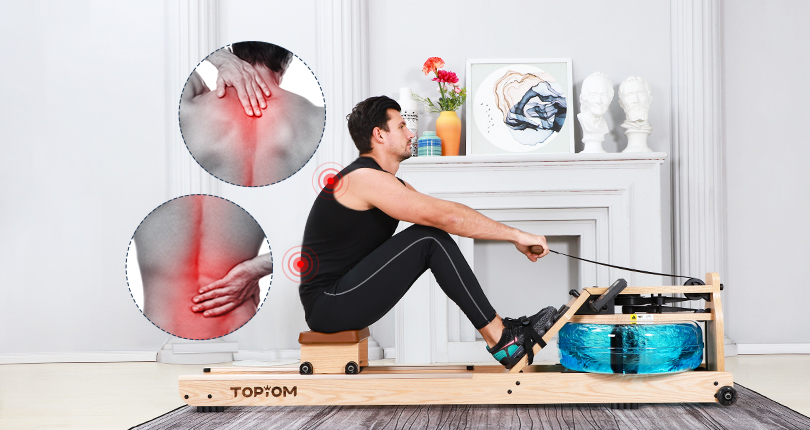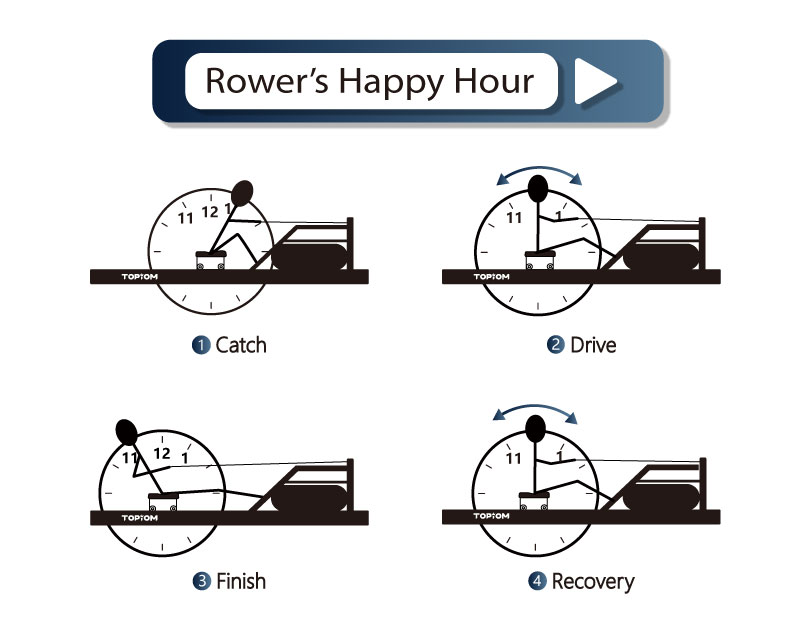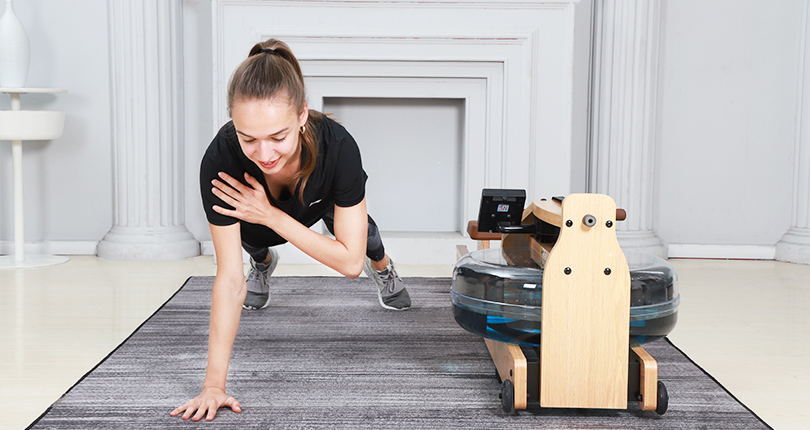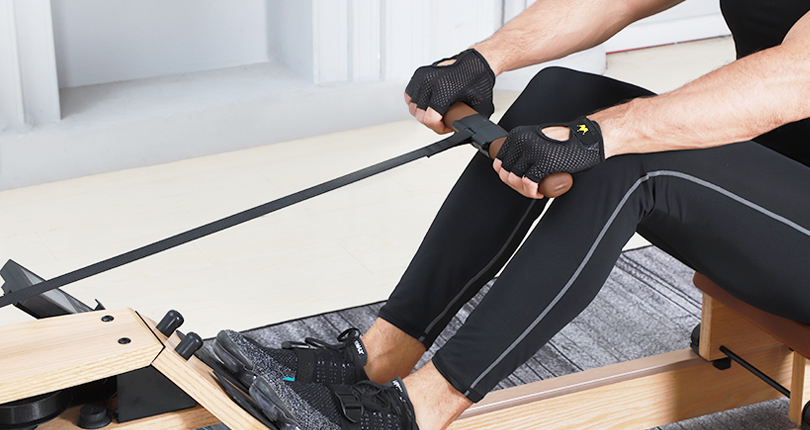Nowadays, the rowing machine is gaining in popularity. Being low-impact, a rowing workout can tone your muscles, raise your heart rate, blast fat, and relieve stress all at once. It’s one of the easier sports to pick up, but not everyone knows how to row. In this post, we’ll walk through some of the most common rowing machine mistakes and provide you with the fixes, helping you to reap the benefits of rowing more effectively.
If you’ve decided to incorporate indoor rowing into your training routine, but you have no idea about how to actually work out on a rowing machine.
Well, we’ve got your back!
Firstly, embark on your workout journey with some basics of indoor rowing technique. Rowing is a learned movement, but it’s quite simple. However, if you haven’t acquired the basic technique properly, it’s easy to make mistakes.
Secondly, learn the most common mistakes people make when using a rowing machine and the quick fixes. Increase your awareness and avoid being a victim of these common rowing mistakes.
Rowing Machine Mistakes and Fixes:
Rowing Mistakes: #1 – Rowing with Your Arms Only
Among the most common misconceptions about rowing is that it’s all about the arms. When using a rowing machine for the first time, new rowers tend to let your arms do all the work. However, it’s the exact opposite.
Rowing engages 86 percent of your muscles. Each stroke involves 65 to 75 percent legs (glutes, quadriceps, calves) and 25 to 35 percent upper body (arms, pectorals, abdominals, upper back) effort.
–American Fitness Professionals Association.
Why Fix It?
Reason #1: If you start up the rhythm with your arms, you’ll put a severe strain on your upper body. It will then lead to an injury.
Reason #2: As the rowing machine is centered around your legs. The movement is most definitely responds better to a push. A powerful leg drive starts every stroke and mobilizes your quadriceps, hamstrings, and gluteals to fire up to push you along. Thus, you can create more power and burn more calories.
How to Fix It?
Push, Don’t Pull!
Change the way you approach this movement. Push with your legs and followed by a slight backward hip hinge. Then follow through with a pull using your arms all while keeping the core muscles engaged. Use your whole body to create a proper rowing form. It’s important to use the power of your legs for each stroke by pushing against the foot panels where your feet are strapped in.
Rowing Mistakes: #2 – Hunching Your Back
Many rowers row with improper posture on the rowing machine. Most commonly, the rowing machine mistakes come in hunching your back. It causes the shoulders to rise, the chest to sag, and the lower back to slump.

If you’ve got a bad habit of hunching over at your desk, odds are good that your body will naturally assume that same position when you sit down at a rower.
You would never want to hunch your back during a Squat or a Deadlift. Likewise, you want to keep your shoulders down and back and your spine in an upright, neutral posture as you go through the rowing stroke.
Why Fix It?
Reason #1: Hunching your back means your muscles aren’t given the space they need. You’re not using the full potential of those muscles. Moreover, you’re putting strain on your back, which will cause low back pain.
Reason #2: Rowing exercises help improve heart and lung function. However, a hunched back will significantly reduce lung capacity. Not to mention help you reap the cardiovascular benefits.
How to Fix It?
During your workout, focus on engaging your core so that you’re in a strong, supported position. By turning on your abs, you can keep yourself upright and your spine will be always in neutral.
Relax your shoulders but not arch or hunch. In this way, your shoulders can pull back and down.
Work on your posture during your regular day will also help you stop slouching your back when you work out on the rower.
Or, try this: Picture your body as the hand of a clock. Ideally, rower’s happy hour served between 11 o’clock and 1 o’clock. It’s a metaphor describing the positions of your back while rowing. It’s in a 1 o’clock position at “the catch” and an 11 o’clock position at the finish or full extension.

Rowing Mistakes: #3 – Extreme Layback
In order to get length in the stroke, you might be inclined to pull the handle all the way to the face, resulting in an extreme layback. This is also a mistake most rowers make at the end of the drive phase or the finish phase.
Why Fix It?
Reason #1: An extreme layback is a weak position. It doesn’t contribute powerful length to your stroke. As the power is lost in this case and you don’t perform an effective stroke.
Reason #2: You’re putting strain on your lower back and hip and will result in muscle soreness, lower back pain, and butt pain.
How to Fix It?
Get long in the front, while keeping the knees just under the arms, the hamstrings loaded and the back tight. Engage your core to find a powerful and comfortable finish.
Rowing Mistakes: #4 – Mixing Up the Sequence of Movements
You mix up the sequence of movements and row in the wrong order.
On the drive phase of the stroke, do you use your bodies or your arms too soon.
Are you firing your arms and legs at the same time, leaning back before your legs have finished pushing, or not bringing your arms back out until after your legs are bent at the catch.
Why Fix It?
Reason #1: There is a proper rowing machine technique to follow. If you start out with the wrong pattern, then you might mess up the entire workout.
Reason #2: If you’re ALL SYSTEMS GO, you could be putting unnecessary strain on your upper body and back.
How to Fix It?
Whether you follow the right order? You can try to row without strapping your feet into the machine. If you can’t keep your feet in contact with the footholds, something is out of order.
Focus on pushing with the legs first, hinging your upper body slightly backward, then pulling your arms into your chest at the bottom of your ribcage.
Go through the same order in reverse on the recovery portion of the stroke—arms away, rocking upper body forward, then bending your legs into position to begin the next stroke.
When you hop on a rowing machine, follow a 6-word mantra for the sequence of performing a correct stroke, i.e., “legs, core, arms” and then “arms, core, legs“.
Follow this sequence and stick to it. Slow down, and get the right rhythm.
Rowing Mistakes: #5 – Going Too Fast
If your seat bangs into the back of your heels with every stroke, or if you go too fast to get the full range of motion, you might want to slow things down.
Just because you’re rowing at 32 strokes per minute doesn’t mean you’re creating bigger output or producing more power. Rushing the process can not help you achieve success in rowing.
Why Fix It?
Being the fastest isn’t necessarily equivalent to having the best workout.
If you practice rowing, you will be able to row faster and with more confidence. You also want to make sure you also have good comprehension as well. It’s much better to be slow and correct than be fast and make tons of mistakes.
If you’re slow and correct, you can easily improve the way in which you work out on the rowing machine. But first, you’ve got to practice. Eventually, you’ll feel like you can row like a pro!
How to Fix It?
Establish a rhythm. Technically, the ratio of your stroke should be 1:2 (drive, recovery), expending maximum energy then relaxing before taking your next stroke.
Slower, full strokes will win the race! In order to reap the best results, don’t rush. Create a controlled speed and go slightly slower to make sure you’re rowing with the correct form.
Just like the Olympic rower Stephen King said once: “The concept is learning how to turn those muscles on and off at the right timing in order to actually create the biggest output. And that’s where you’re going to become most successful. Slow things down, let technique be the primary focus, and the number will come later.”
Rowing Mistakes: #6 – Not Warming Up and Cooling Down
Work out hard without getting your body prepared or stop your indoor rowing workout abruptly without cooling down. Either of them is a no-no in any fitness situation.
Why Fix It?
If you don’t warm up before exercising, this will keep you from getting the maximum benefit from your effort and may even put you at risk of injury. Working hard without warming up can cause unnecessary stress and strain on your muscles, especially your heart.
If you stop your indoor rowing workout abruptly without cooling down, your muscles will suddenly stop contracting vigorously. This can cause blood to pool in the lower extremities of your body, leaving your blood without as much pressure to be pumped back to the heart and brain.
How to Fix It?
A rowing session should incorporate a good warm-up and cool-down.
You can start with some reverse lunges, pushups, hamstring stretches, and walkouts. Add a push-up when you’re in the plank position to help open up your hamstrings, lower back, and chest, as well as fire up your abs. You may also warm up by rowing lightly for 3–5 minutes.

A good cool-down should be down for the main muscle groups used in your rowing session. It should take them through a similar range of motions used in the main session but at a gradually decreasing intensity, allowing your body to resume its regular heartbeat and breathing patterns in its own time. Stretches to develop flexibility should also be done as part of a cool down.
Rowing Mistakes: #7 – Forgetting to Breathe
It may seem like a given, but many people tense up through their traps and end up holding their breath.
Why Fix It?
Like swimming or running, rowing is a rhythmic activity-and syncing up your rhythm with your breath can make it all feel much easier and help you recover more quickly.
How to Fix It?
Stay Relaxed & Breathe
Focus on staying relaxed in the shoulders and pulling with your lats, as well as breathing on every pull or every other pull.
It’s helpful to coordinate the timing of your breathing with the movements of the stroke.
- During low-intensity rowing (one breath)—Exhale gradually on the drive, expelling all remaining air at the finish. Inhale on the recovery.
- During high-intensity rowing (two breaths)—Exhale as you finish the drive. During the recovery, inhale, then exhale quickly. Inhale again just before the catch.
Whatever you do, don’t forget to breathe!
Rowing Machine Mistakes: #8 – Improper Grip of the Handle
Very few novice rowers hold their handles correctly. Some clamp on so tightly (death grip) that you can see their knuckles turn white. Others hold the handle so loosely and actually take their fingers off the handle at odd moments (piano playing). Quite a few people even hold the handle with an underhand grip.
Why Fix It?
The improper grip can easily lead to blisters and muscle strain. grip like this will create unnecessary tension in your forearms.
How to Fix It?
Your fingers should wrap around the handle so your second knuckles face forward with your thumbs on the underside of the handle. The top of your wrist should also be completely flat, and not rolled to the outside.
Other tips for a proper grip:
WIDE GRIP with your pinkies on the handle not dripped off the outside.
THUMBS UNDER.
RELAXED GRIP, neither death gripping nor piano playing the handle, but have a nice loose grip.
PRONATED GRIP, also known as OVERHAND GRIP, meaning you grip the handle with your palms down.
Master the BEST WAY TO HOLD A HANDLE will give you a better rowing experience. Besides a proper grip technique, you can protect your hands by wearing proper indoor rowing gloves.

Rowing Mistakes: #9 – Rowing behind Your Hips
Do you row with your back curved and your hips rolled forward? You don’t sit correctly and you are rowing behind your hips.
Why Fix It?
Reason #1: If you don’t sit correctly, you sabotage your power.
Reason #2: Improper sitting may lead to injury.
How to Fix It?
Think of your torso as stacked right on top of your hips. Try practicing rowing with only your torso. With your legs and arms extended, hinge backward and forward from the hips.
By isolating the second part of the drive phase—when your torso hinges after your legs straighten—you can focus on feeling the seat move under you.
The Bottom Line
If you’ve been making these common rowing machine mistakes, don’t worry. You are not alone and you do have the power to fix them. Just take a deep breath and tell yourself that making mistakes is just a part of the learning process.
Take the lessons you’ve learned, try the fixes, and row forward. When you turn each mistake into a learning opportunity, you’ll grow stronger and more capable with each mistake you make.
When you get on to the rowing machine, change the height of the monitor to eye level and adjust the footplate to help improve your posture, sit more comfortably and get a good starting position.
Pay careful attention to your stroke, avoid those common rowing machine mistakes that prevent you from reaping the full benefits of the rowing machine. Practice and perfect your form session by session. Before you know it, you’ll get the most out of your time on the rowing machine and reap all its benefits.
Enjoy yourself and have fun as you learn and row your way to a happier stroke!

